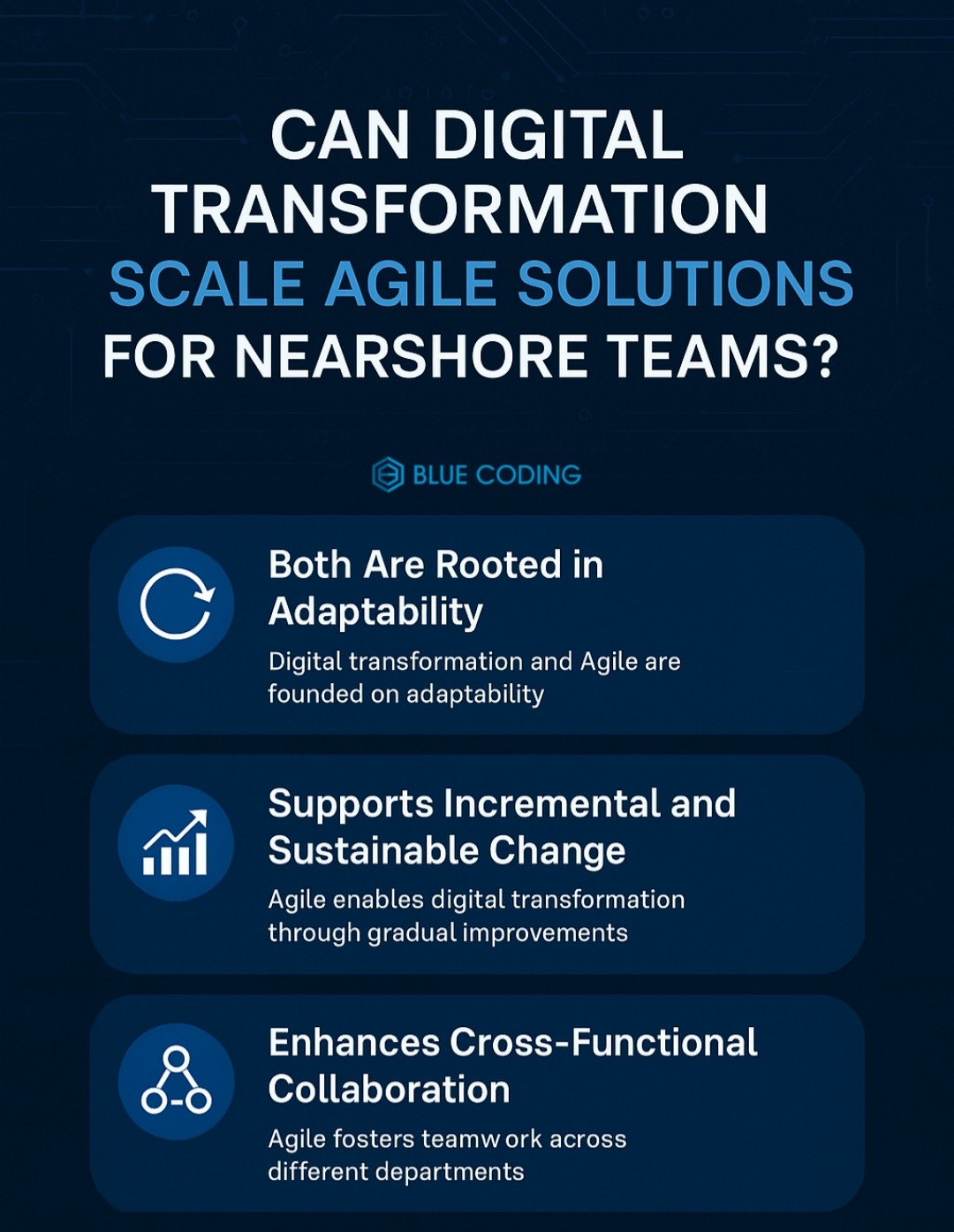 News
News
Businesses are experiencing increasing pressure to innovate faster while maintaining efficiency and quality. Agile methodologies have already proven their value in improving software development cycles, and many companies are now blending Agile with nearshore development to accelerate results. But here’s the real question: can digital transformation take Agile to the next level and truly scale its benefits across nearshore teams? Digital transformation means changing how teams collaborate, how processes are optimized, and how businesses deliver value. In this blog post, we explore how digital transformation scale Agile solutions can empower Agile methodologies to perform even better within nearshore software development environments.
Why Digital Transformation Is a Natural Fit for Agile Practices
Both Are Rooted in Adaptability.
Digital transformation and Agile share the same foundational trait, adaptability. While digital transformation focuses on reimagining business models and processes using technology, Agile emphasizes iterative progress, feedback loops, and responsiveness to change. In fast-moving industries, this synergy allows businesses to evolve quickly without losing momentum. Agile methodologies offer the perfect rhythm for teams undergoing digital change because they thrive on uncertainty and continuous improvement. When both practices are aligned, companies can test innovations in real time, learn fast, and scale what works.
Supports Incremental and Sustainable Change.
One of the biggest risks in any transformation is overwhelming teams with massive, sweeping changes. Agile minimizes this risk by promoting incremental development. Instead of overhauling the entire system at once, teams can deliver small, manageable updates that build toward the bigger digital goal. This makes the transformation process less disruptive and easier to manage across departments, especially in nearshoring agile solutions environments where cross-team communication is key. With Agile, digital transformation becomes a series of purposeful steps, each informed by real user feedback, rather than a single unpredictable leap.
Enhances Cross-Functional Collaboration.
Digital transformation isn’t just a tech initiative, it touches every part of the business. Agile encourages cross-functional collaboration, breaking down silos between IT, marketing, design, and operations. This level of alignment is crucial for transformation success. With Agile ceremonies like daily standups, retrospectives, and sprint planning, teams stay connected, aligned, and informed at every stage. For nearshore teams in particular, this structure fosters communication that bridges time zones and cultures, helping digital projects move forward efficiently and transparently.
Encourages a Culture of Continuous Innovation.
Digital transformation is not a one-time event, it’s an ongoing mindset shift. Agile complements this by promoting a culture where teams are constantly learning, experimenting, and improving. When embedded into the transformation process, Agile keeps teams future-focused and open to new ideas. Mistakes are treated as data points rather than setbacks, and success is measured by how quickly a team can pivot and try again. This cultural alignment helps businesses remain resilient, responsive, and ready for whatever comes next, especially in fast-evolving digital markets.
Overcoming the Scaling Challenge: Why Agile Alone Isn't Enough
While Agile works great for small, co-located teams, it often runs into roadblocks when applied to larger, distributed teams without the right infrastructure. Digital transformation helps fill those gaps. Scaling Agile means more than just adding more developers to the team. It requires coordination, visibility, and consistent communication. That’s where digital transformation strategies come in. Enterprise Agile frameworks like SAFe (Scaled Agile Framework) and LeSS (Large-Scale Scrum) benefit significantly from digital dashboards, performance metrics, and process automation.
Nearshore teams can leverage these tools to streamline workflows and make the product life cycle more efficient. For example, automated reporting systems can help senior management monitor progress without requiring endless status meetings, while collaborative tools like Confluence, Jira, and Slack ensure all team members stay aligned.Digital workflows also provide a single source of truth. This minimizes misunderstandings, especially when working with cross-functional teams located in different countries. A shared digital ecosystem ensures that everyone, from product managers to testers, is always on the same page.

Building Nearshoring Agile Solutions Teams with the Right Digital Foundations
To make the most of Agile within nearshore teams, businesses need to build a digital infrastructure that supports growth and adaptability. Here are a few key components:
Cloud-Native Environments Make Scalability Effortless:
Agile thrives in environments where teams can move fast, experiment safely, and scale without hitting bottlenecks, and that’s exactly what cloud-native solutions enable. Platforms like AWS, Azure, and Google Cloud Platform (GCP) offer a strong backbone for nearshore Agile teams to deploy new features, run tests, and manage infrastructure on-demand. Instead of waiting on physical servers or local setups, cloud environments allow distributed teams to spin up staging environments in minutes, replicate production conditions, and keep development cycles moving without friction. For nearshore teams working across time zones, this flexibility is key. It removes traditional infrastructure delays and empowers teams to stay agile, even when scaling across borders.
Security-First Architecture Builds Trust from the Start:
With global collaboration comes the need for rock-solid security. Nearshore agile software dev is all about speed and iteration, but without a secure foundation, speed can quickly turn into vulnerability. That’s why a digital transformation strategy supporting Agile must include a security-first approach. This means implementing end-to-end encryption, role-based access control, and compliance with regulations when relevant. It’s especially critical when nearshore teams handle sensitive customer data or proprietary code. Secure DevOps practices like secrets management, automated compliance scanning, and regular security testing, ensure that teams can move fast and safely. When nearshore teams are backed by secure systems, stakeholders are more willing to trust the process and greenlight innovation.
Smart Communication Tools Keep Collaboration Human:
No digital transformation is complete without strong communication workflows, especially for Agile teams spread across countries. Tools like Slack, Microsoft Teams, and Zoom are no longer “nice to have” and instead, they’re the glue that keeps nearshore teams in sync. Beyond just video calls, modern tools enable real-time messaging, collaborative whiteboarding, and seamless file sharing, helping teams work as if they’re in the same room, even when they’re not. Agile thrives on quick feedback and constant dialogue, and these tools make that possible. More importantly, they reduce the isolation that often comes with remote work. For nearshore teams looking to replicate the natural flow of in-office collaboration, smart communication platforms are non-negotiable.
Automated Testing and Monitoring Make Iteration Safer:
The pace of nearshore agile software dev only works when quality doesn’t take a hit, and that’s where automation steps in. Automated testing frameworks like Selenium, Cypress, or Jest, combined with CI/CD pipelines, help nearshore teams catch bugs early and push code with confidence. Meanwhile, real-time monitoring tools allow developers to keep an eye on performance, uptime, and potential issues without manually digging through logs. This kind of automation supports the Agile principle of “working software over documentation.” It also gives teams the freedom to innovate without fearing that one small change will break the system. For distributed teams where time zone overlaps are limited, these tools act as an extra layer of safety and efficiency, keeping products running smoothly while development continues around the clock.
Maximizing Results: How Digital Transformation Future-Proofs Nearshore Agile Teams
Agility in software development is no longer just a methodology; it’s a mindset that needs to permeate across the organization. By aligning digital transformation goals with Agile principles, companies future-proof their operations against shifting market demands.
For nearshore teams, this means:
Better talent utilization: Digital tools make it easier to onboard, train, and manage nearshore developers, which can help fill skill gaps quickly.
Greater flexibility: As projects evolve, teams can pivot faster using digital platforms without redesigning workflows.
Improved client satisfaction: With more predictable delivery cycles, transparent reporting, and real-time collaboration, client relationships grow stronger.
Ultimately, digital transformation doesn’t replace Agile, it enhances it. And when applied strategically, it turns nearshore teams into a high-performance engine that drives innovation, speed, and quality.
Thinking Of Choosing Blue Coding?
At Blue Coding, we live and breathe nearshore Agile. We’ve helped companies across North America build high-performing, adaptable dev teams that aren’t just “remote”, they’re integrated, efficient, and ready to scale. Whether you're navigating digital transformation or just need a team that actually gets Agile (and sticks to your sprint deadlines), we’ve got your back. Let’s build something smart together. Contact us as your next great nearshore team is just one click away with us! We even offer free strategy calls.



